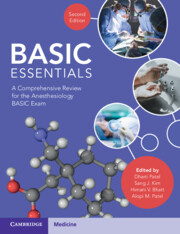Book contents
- BASIC Essentials
- BASIC Essentials
- Copyright page
- Contents
- Contributors
- Preface
- Abbreviations
- Chapter 1 Anatomy
- Chapter 2 Anesthesia Delivery Systems
- Chapter 3 Monitoring Methods
- Chapter 4 Ventilators, Alarms, and Safety Features
- Chapter 5 Defibrillators
- Chapter 6 Electrical, Fire, and Explosion Hazards: Basic Electronics
- Chapter 7 Basic Mathematics and Statistics
- Chapter 8 General Pharmacology
- Chapter 9 Anesthetics: Gases and Vapors
- Chapter 10 Opioids
- Chapter 11 Intravenous Anesthetics
- Chapter 12 Local Anesthetics
- Chapter 13 Muscle Relaxants (Depolarizing, Non-Depolarizing)
- Chapter 14 Understanding the Role of the Anesthesia Preop Evaluation
- Chapter 15 Preparation for General Anesthesia and Premedication
- Chapter 16 Regional Anesthesia
- Chapter 17 General Anesthesia
- Chapter 18 Monitored Anesthesia Care and Sedation
- Chapter 19 Intravenous Fluid Therapy in the Perioperative Period
- Chapter 20 Complications of Anesthesia: Etiology, Prevention, and Treatment
- Chapter 21 Postanesthesia Recovery Period: Analgesics
- Chapter 22 Postoperative Period: Consequences of Anesthesia and of Surgical Incisions
- Chapter 23 Central and Peripheral Nervous System
- Chapter 24 Pain Mechanisms and Pathways
- Chapter 25 Autonomic Nervous System
- Chapter 26 Central Nervous System: Anatomy
- Chapter 27 Respiratory System: Physiology
- Chapter 28 Respiratory System: Anatomy
- Chapter 29 Respiratory System: Pharmacology
- Chapter 30 Cardiovascular Physiology
- Chapter 31 Basics of Cardiopulmonary Resuscitation, Medications, Defibrillators, and Advanced Cardiac Life Support Algorithms
- Chapter 32 Cardiovascular System: Anatomy
- Chapter 33 Cardiovascular System: Pharmacology
- Chapter 34 Anesthesiology for the Gastrointestinal and Hepatic Systems
- Chapter 35 Renal Anatomy and Physiology
- Chapter 36 Renal Pharmacology
- Chapter 37 Hematologic System: Coagulation, Anticoagulation, Antiplatelet, and Thrombolytics
- Chapter 38 Transfusions
- Chapter 39 Reactions to Transfusions
- Chapter 40 Endocrine and Metabolic Systems
- Chapter 41 Neuromuscular Physiology and Disorders
- Chapter 42 Special Problems or Issues in Anesthesiology
- Chapter 43 Appendix
- Index
- References
Chapter 3 - Monitoring Methods
Published online by Cambridge University Press: 21 February 2025
- BASIC Essentials
- BASIC Essentials
- Copyright page
- Contents
- Contributors
- Preface
- Abbreviations
- Chapter 1 Anatomy
- Chapter 2 Anesthesia Delivery Systems
- Chapter 3 Monitoring Methods
- Chapter 4 Ventilators, Alarms, and Safety Features
- Chapter 5 Defibrillators
- Chapter 6 Electrical, Fire, and Explosion Hazards: Basic Electronics
- Chapter 7 Basic Mathematics and Statistics
- Chapter 8 General Pharmacology
- Chapter 9 Anesthetics: Gases and Vapors
- Chapter 10 Opioids
- Chapter 11 Intravenous Anesthetics
- Chapter 12 Local Anesthetics
- Chapter 13 Muscle Relaxants (Depolarizing, Non-Depolarizing)
- Chapter 14 Understanding the Role of the Anesthesia Preop Evaluation
- Chapter 15 Preparation for General Anesthesia and Premedication
- Chapter 16 Regional Anesthesia
- Chapter 17 General Anesthesia
- Chapter 18 Monitored Anesthesia Care and Sedation
- Chapter 19 Intravenous Fluid Therapy in the Perioperative Period
- Chapter 20 Complications of Anesthesia: Etiology, Prevention, and Treatment
- Chapter 21 Postanesthesia Recovery Period: Analgesics
- Chapter 22 Postoperative Period: Consequences of Anesthesia and of Surgical Incisions
- Chapter 23 Central and Peripheral Nervous System
- Chapter 24 Pain Mechanisms and Pathways
- Chapter 25 Autonomic Nervous System
- Chapter 26 Central Nervous System: Anatomy
- Chapter 27 Respiratory System: Physiology
- Chapter 28 Respiratory System: Anatomy
- Chapter 29 Respiratory System: Pharmacology
- Chapter 30 Cardiovascular Physiology
- Chapter 31 Basics of Cardiopulmonary Resuscitation, Medications, Defibrillators, and Advanced Cardiac Life Support Algorithms
- Chapter 32 Cardiovascular System: Anatomy
- Chapter 33 Cardiovascular System: Pharmacology
- Chapter 34 Anesthesiology for the Gastrointestinal and Hepatic Systems
- Chapter 35 Renal Anatomy and Physiology
- Chapter 36 Renal Pharmacology
- Chapter 37 Hematologic System: Coagulation, Anticoagulation, Antiplatelet, and Thrombolytics
- Chapter 38 Transfusions
- Chapter 39 Reactions to Transfusions
- Chapter 40 Endocrine and Metabolic Systems
- Chapter 41 Neuromuscular Physiology and Disorders
- Chapter 42 Special Problems or Issues in Anesthesiology
- Chapter 43 Appendix
- Index
- References
Summary
An invasive continuous blood pressure monitoring method.
- Type
- Chapter
- Information
- BASIC EssentialsA Comprehensive Review for the Anesthesiology BASIC Exam, pp. 16 - 19Publisher: Cambridge University PressPrint publication year: 2025

